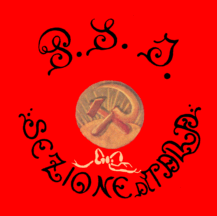
by Marcus Schmöger, 18 August 2002

Last modified: 2009-02-28 by dov gutterman
Keywords: italy | psi | italian socialist party | partito socialista italiano |
Links: FOTW homepage |
search |
disclaimer and copyright |
write us |
mirrors
See also:
in the book I recently found (L'immagine del socialismo; [bgp82]) there are fotos of 15 old flags of different sections of the Italian Socialist Party (Partito Socialista Italiano = PSI). There is not much info on these flags in the book, only that they date from the late 19th century to about 1920. The flags show on a usually red field typical socialist symbols such as hammer&sickle, wheat ears, rising sun, clasping hands. Furthermore the inscription of the name of the party section and socialist mottos such as "Proletarii di tutti i paesi unitevi!" (Proletarians of all countries, unite!) or "Chi non lavora, non mangia" (Who doesn't work, doesn't eat). The symbols on the flags are usually embroidered or painted. Although I think that the fotos in the book only show the central part of slightly larger flags (there are no edges visible, no fringe etc), my images are showing this central part illustrated in the book in standard size.

by Marcus Schmöger, 18 August 2002
First is a flag of the "Sezione di Talla" (Tuscany,
Arezzo province), which shows beside the inscriptions
"P.S.I." and "Sezione di Talla" a central
emblem consisting of hammer&sickle and a rising sun. On the
foto there are some traces of wheat (or other grain) ears around
this emblem,
that I could not show in the image.
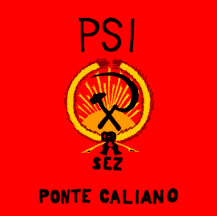
by Marcus Schmöger, 18 August 2002
Second is a flag of the "Sezione di Ponte Caliano" (also Tuscany, Arezzo province), showing grain ears around hammer&sickle and raising sun, as well as the inscriptions "PSI", "SEZ" (for "sezione") and "PONTE CALIANO"
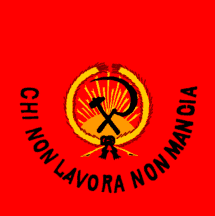
by Marcus Schmöger, 18 August 2002
The third seems to be (at least to me) the reverse of previous one, as it shows exactly the same central emblem, with the inscription "Chi non lavora, non mangia" (Who doesn't work, doesn't eat).
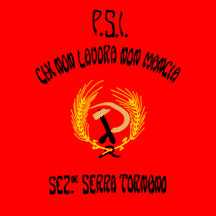
by Marcus Schmöger, 18 August 2002
The fourth flag also shows the inscription "Chi non lavora, non mangia" (Who doesn't work, doesn't eat) as well as the inscriptions "P.S.I." and "SEZ.ne SERRA TORNANO" which seems to be rather the name of a person than of a municipality. The central emblem shows grain ears around hammer&sickle; the metallic parts of hammer&sickle seem to be represented by some metallic material (gold leaf?) on the flag.
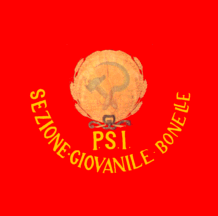
by Marcus Schmöger, 18 August 2002
Sezione Giovanile Bonelle (= Youth section Bonelle) (Pistoia province, Tuscany). Beside the inscriptions this flag shows grain ears, hammer& sickle and a raising sun.
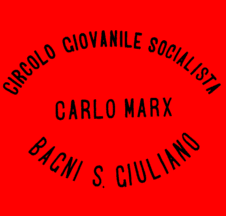
by Marcus Schmöger, 18 August 2002
"Circolo Giovanile Socialista Carlo Marx" (Socialist Youth Circle "Karl Marx") Bagni San Giuliano (Pisa province??). This flag only shows black inscriptions on red.

by Marcus Schmöger, 18 August 2002
Vecchiazzano section (Forli province, Emilia-Romagna). The flag shows grain ears, hammer&sickle and rising sun in the center; furthermore the inscription "P.S.I Sezione Socialista Andrea Costa Vecchiazzano (Forli)" (PSI Socialist Section Andrea Costa Vecchiazzano (Forli))
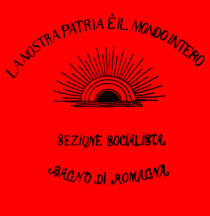
by Marcus Schmöger, 18 August 2002
"Sezione socialista" (Socialist section) Bagno di Romagna (Forli province, Emilia-Romagna). This flag shows a rising sun in black outline, the name of the party section and the motto "La nostra patria e il mondo intero" (Our fatherland is the whole world).
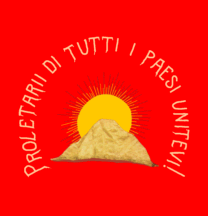
by Marcus Schmöger, 18 August 2002
This flag (no idea, where it is from) shows a rising sun behind a golden mountain, around this emblem the inscription "Proletarii di tutti i paesi unitevi!" (Proletarians of all countries, unite!)
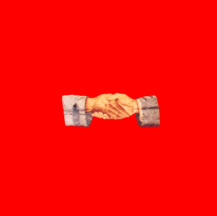
by Marcus Schmöger, 18 August 2002
This flag (no idea, where it is from) shows on a red background two clasping hands, a well-known socialist symbol of solidarity.
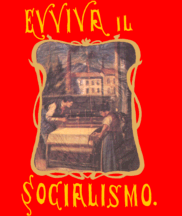
by Marcus Schmöger, 18 August 2002
This shows on a red background an industrial scene: in the
background industry buildings, in the foreground a man and a
woman working on a machine. The inscription in gold reads
"Evviva il Socialismo." (Long live the socialism)
Marcus Schmöger, 18 August 2002